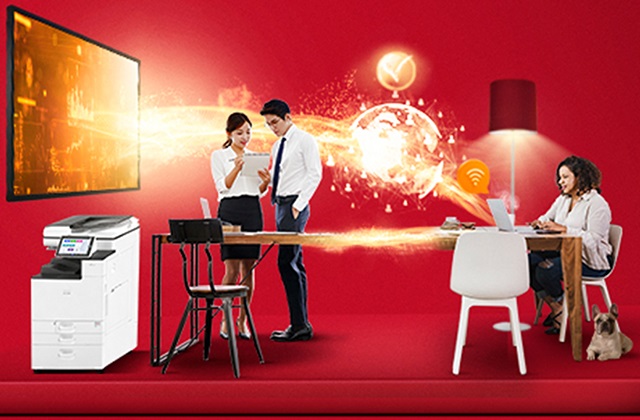The AV industry’s moving parts

The sheer scale of the annual Integrated Systems Europe (ISE) exhibition never fails to impress. This year was no different; having attracted nearly 74,000 audio-visual (AV) industry experts and enthusiasts from over 162 countries, the event certainly earns its status as the world’s largest AV and systems integration exhibition.
ISE not only provides significant networking opportunities for the AV industry, but it also encourages collaborative progression and innovation within the sector. For us at Ricoh, it provides a tremendous opportunity to share our latest integrated portfolio and to gather our teams across Europe to engage with our customers and partners, as well as reflect on how we can continue to stay ahead of the curve. The participation of our Ricoh family businesses in one place was a welcomed addition.
The onset of the pandemic quickly prompted a shift towards flexible ways of working for many businesses, and a few years on, it's clear that it's here to stay. Consequently, we have seen a convergence of the AV and IT industries, as they work together to meet new market demands. At ISE, we saw vendors and suppliers exhibiting their latest integrated solutions that support businesses to run as smoothly as possible. This was a great opportunity for Ricoh, as integration of IT capabilities within our AV offerings has always been an essential part of our framework.
No matter the players, clear market trends emerged at this year’s ISE. Whether leveraging emerging technologies, taking on more of a management/consultant role or becoming greener, the industry is certainly adapting to new market demands.
Emerging technologies germinate
From artificial intelligence (AI) to virtual reality (VR), there are many technologies are still very much in the germination phase, and there is undoubtedly more to come. Naturally, there’s hesitation on how it will be implemented and the impact they will have on workforces. But the way these technologies have been deployed thus far have certainly helped to build excitement. The next phase of opportunity is in supporting businesses to find the most beneficial ways of incorporating these technology ‘trends’ into tangible returns.
In the workplace, for example, AI technologies have been embedded within meeting spaces and workspace management platforms to make hybrid and remote working as seamless as possible. Many meeting room cameras now use AI directors to enable continuous optimisation of camera angles and views in a session, while AI-enabled speaker tracking ensures an uninterrupted listening experience for all.
In the case of VR, its again early stages, but there is much to look forward to. At Ricoh, we are already embedding VR tools into our solutions to reduce friction points for our users. For example, by creating a 3D virtual space with IoT integration, we allow organisations to monitor and manage their meeting rooms with ease, enhancing how their employees can collaborate and work more seamlessly.
While AI and VR may be the latest buzzwords, we don’t expect them to go anywhere any time soon. Instead, we look forward to seeing their practical applications at next year’s ISE.

Demand for AV management rises
As businesses find themselves having to implement more and more AV equipment, there has been a slow but steady increase in businesses looking for their suppliers and vendors to not only provide, but to be responsible for managing their AV needs.
For Ricoh, our combined AV and IT capabilities mean that we can provide users with the proactive AV management model they’re increasingly looking for through our Managed Services offering. For example, by leveraging increased intelligence and technologies such as AI within our own monitoring and management platforms, enterprises can avoid the disruption of meeting delays or user frustration that can negatively impact the efficiency and satisfaction of employees.
Given the volatile global economic climate, there has been a growing level of interest from businesses in moving away from investing in AV technologies as a capital expenditure, but instead viewing the investment as an operating expense. As such, some of our customers are spreading the cost of assets and projects using our financing solution Ricoh Capital.
By classifying AV ventures as an operating expense instead of a large, up front capital expense, businesses can more readily manage their cashflow by spreading the cost over the life of their investment. This approach comes with minimal administration as all AV products and services are wrapped together, meaning less contracts to manage and the need for only one monthly or quarterly invoice. All in all, this creates less hassle and a clearer view for budgeting, reporting, and auditing purposes.
Leasing also ensures your organisation has access to the latest technology through renting rather than owning – making it easier and more cost effective to refresh your technology when it nears the end of its service life.
Sustainability takes root
For perhaps the first time, sustainability (and the wider ESG agenda) was a primary topic of conversation at ISE – across all stands and zones. And it’s no surprise. Concern for sustainability has shifted from an observation to a priority agenda point. While some businesses may have previously declared intent to work on their sustainability goals, we are now seeing a marked shift towards companies taking real action to reduce negative environmental impacts.
Consequently, there is clear demand across the industry for technology providers, integrators and vendors to do more to help businesses meet their environmental, social and governance (ESG) goals. At Ricoh, striving towards competitive ESG targets is part of the fabric of our company; we were recently recognised as one of the Global 100 Most Sustainable Corporations, as well as part of S&P Global’s top 1% of companies with outstanding sustainability efforts.
As such, we’ve been having these conversations with our partners for some time, continuing our sustainably minded approach to market. So far, conversations have centred on the benefits of implementing virtual or hybrid meetings, as well as the measures of occupancy and temperature. By optimising spaces and correcting temperatures, we can reduce a businesses’ carbon footprint as the need to travel decreases.
At Ricoh, we have been focusing on optimising the technologies that enables this new norm, ensuring that we not only choose energy efficient devices, but that our Managed Services play a part in the continued monitoring, automation, and optimisation of devices to focus on energy efficiency. For example, our teams can leverage the capabilities of platforms to automate power cycling of technology throughout the evenings and weekends to create a sustainable maintenance practice that can be evidenced through data insights and reporting.
However, substantial change cannot happen alone; much like other industries, the AV sector will need to collaborate to inspire positive environmental change. Whether it’s carbon labelling or reporting, we must work together across the entire value chain to get this right.
Going forward, we should push the AV industry to further collaborate, in order to successfully and sustainably deliver progress.
Looking ahead
This year’s ISE showcased a dynamic AV landscape that is marked by adjustments to meet growing demand for emerging technologies to improve user experience, the heightened demand for comprehensive AV management solutions as well as for increased sustainability measures. As the industry charts its course forward, innovation and collaboration will be the driving forces behind the sector’s progression.

Edward Hamilton
Edward Hamilton, VP & General Manager, Communication Services at Ricoh Europe
Let’s connect
Talk to a Ricoh expert
Transform your workplace with Ricoh’s Managed Print and Automation Services.
Boost efficiency, reduce costs, and accelerate your journey towards digital transformation.














